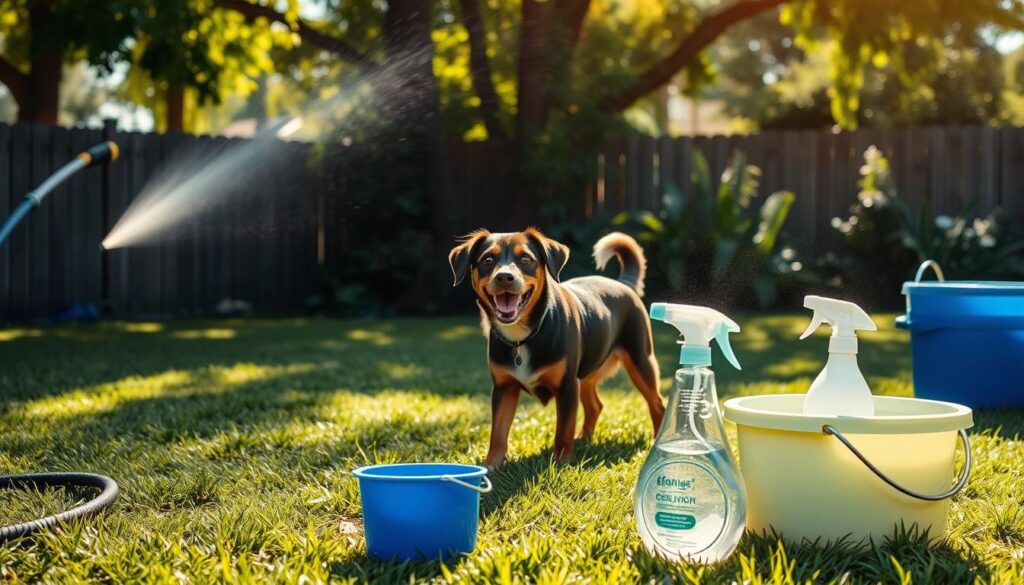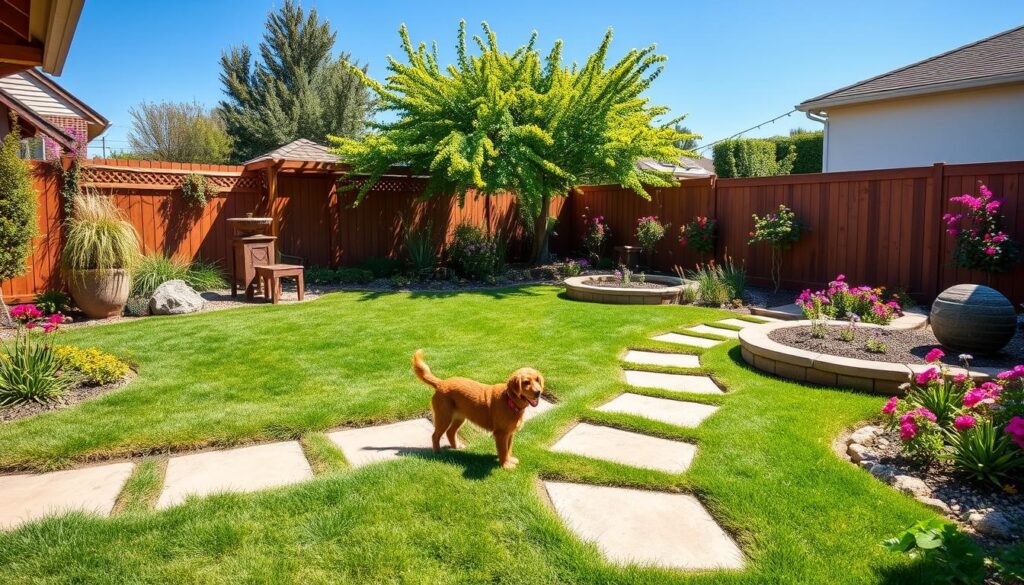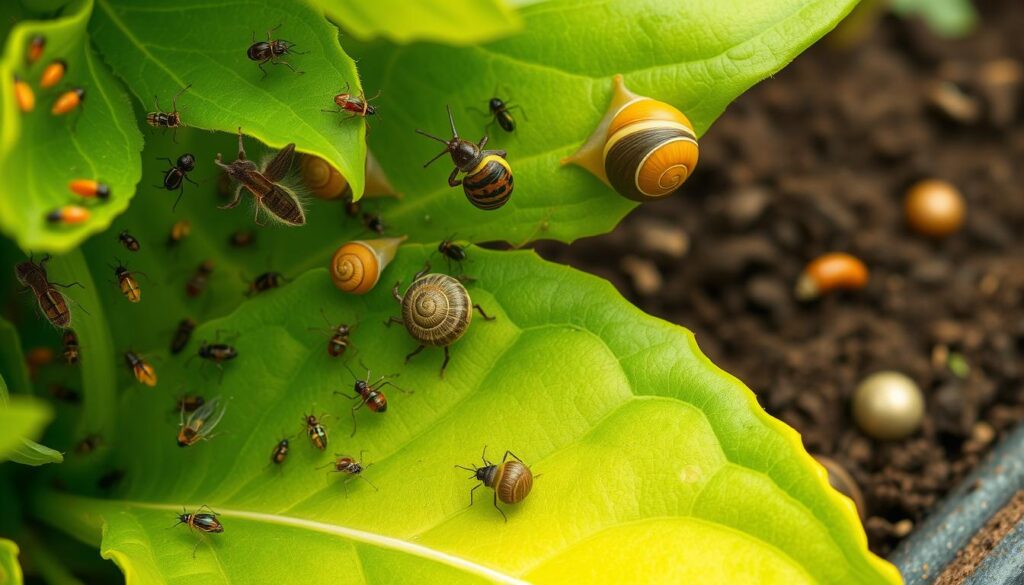Did you know that canine parvovirus can live indoors for months and outdoors for years? This is especially true in dark, moist places. It’s very important to clean your backyard well to keep your dog safe and healthy. As a dog owner, you need to know how to keep your outdoor area safe for your pet.
Key Takeaways
- Canine parvovirus can persist for long periods in the environment, requiring thorough disinfection.
- Proper poop removal and yard sanitization are essential steps to maintain a healthy outdoor space.
- Selecting the right cleaning products and surfaces is crucial for creating a dog-friendly backyard.
- Regular cleaning and maintenance are necessary to ensure the ongoing safety and well-being of your pet.
- Understanding the best practices for outdoor pet areas can help you create a comfortable and low-maintenance dog-friendly space.
Pick Up the Poop!
Keeping your backyard clean is key for your dog’s health and yours. Removing dog waste regularly is a must. Dog poop can carry harmful bacteria and viruses that affect both pets and people.
It’s vital to clean up after your dog. These bacteria grow well in dog waste. So, it’s important to stay on top of this task.
Why Poop Removal is Crucial
Dog waste has harmful bacteria like Salmonella and E. coli. These can cause serious health issues if not disposed of correctly. Dog feces is also more acidic than other animals’ manure, which can harm grass.
Even though manure from other animals can be good for nature, dog waste can pollute waterways. This harms the environment.
The Centers for Disease Control and Prevention say dog waste can harm the environment through water contamination. It’s important to clean up dog poop regularly to keep your yard safe for your dog.
- It is recommended to pick up dog waste before a rainstorm to prevent contamination of local water sources.
- Using the right tools such as spring-loaded scoopers, wire rake scoopers, spade scoopers, and waste bags can help in effective dog poop cleanup.
- The Environmental Protection Agency recommends flushing dog poop down the toilet as a more environmentally friendly disposal option compared to putting it in the trash.
- Properly disposing of dog poop is essential to prevent methane production and water contamination.
- Consistently picking up and disposing of dog waste can help prevent coprophagia in dogs.
By regularly removing dog waste from your backyard, you make a safer and cleaner space for you and your pet.
Sanitizing the Yard
After removing dog waste, it’s important to sanitize the yard disinfection and outdoor surface cleaning. This step gets rid of harmful bacterial and viral elimination. It keeps your pet safe and makes your outdoor space cleaner.
Chlorine-based solutions are great for lawn decontamination. Mixing 4-6 ounces of chlorine with a gallon of water kills bacteria in 20 minutes. This method works fast but isn’t good for plants.
For a deeper clean, use Consan Triple Action 20 or Top Performance 256. These products kill many harmful germs, including E. coli and salmonella. It might take 3-4 days for the lawn to be fully clean.
BioWish Enzymes is an organic option. It uses enzymes to break down waste naturally. It’s better for the environment but might not kill all germs.
Choose your method and make sure to spray and rinse well. This ensures your yard is fully yard disinfection and environmental sanitization. Do this every 6 months if your dogs play outside a lot.
“The longer dog poop stays on the ground, the more pungent the smell becomes, making it harder to eliminate odor.”
Keeping your yard clean is good for your pet and your family. It makes your backyard a nicer place to be.
Maintaining Your Pet’s Health
Keeping your backyard clean is just the start. It’s also key to focus on your dog’s health and happiness. By keeping up with vaccinations and avoiding dangers, you can keep your pet strong and healthy.
Preventive Measures
Regular vet visits and keeping your dog’s vaccinations current are vital. They help keep your pet safe and healthy. This also helps protect your community from diseases.
It’s smart to keep your dog away from standing water. This water can have bad bacteria and parasites. Also, don’t let your dog meet too many new animals. This helps keep them safe in your backyard.
| Preventive Measure | Benefit |
|---|---|
| Up-to-date Vaccinations | Protects against life-threatening illnesses |
| Avoiding Standing Water | Prevents exposure to harmful bacteria and parasites |
| Limiting Contact with Unfamiliar Animals | Reduces the risk of disease transmission |
By taking these steps, you can keep your dog happy and healthy. You’ll also protect them from dangers in the backyard.

Setting Up the Outdoor Kennel
Creating the perfect outdoor kennel for your dog is key to a safe and comfy backyard sanctuary. Outdoor dog kennels should offer shelter and meet your pet’s needs. It’s all about designing a space that’s both cozy and functional.
A well-thought-out canine sanctuary design means your dog has a cozy spot to relax and enjoy the air. Place food, water bowls, and the dog’s bed in easy-to-clean spots. Also, choose weather-resistant pet enclosures to keep your dog’s space healthy and clean.
Here are some kennel setup best practices:
- Use cedar chips, which are better than bark dust because they last longer and keep fleas away. Aim for 6 inches deep for best results.
- Consider synthetic lawn for shady or small yards. It stops muddy spots and makes cleaning up easier. But, it needs regular care to avoid bad smells from dog urine.
- Tall fescue grass, like RTF, is better at handling dog traffic, urine, and digging than regular grass.
The outdoor kennel is for temporary shelter and exercise, not a permanent home. A comfy and safe space ensures your dog’s happiness and keeps your backyard clean and useful.
Safety First
Keeping your dog’s outdoor space clean and safe is crucial. Before you start, make sure your dog is out of the way. It’s also important to wear protective gear like gloves and long pants to keep yourself safe.
Be careful not to mix certain cleaning products. This can release harmful fumes. Always check the labels and avoid mixing pet-safe cleaning solutions. Following these steps will keep you and your pet safe while cleaning.
Precautions for Cleaning
- Remove your dog from the area before starting the cleaning process
- Wear protective gear, such as gloves and long pants, to safeguard yourself
- Avoid mixing cleaning product compatibility as it can produce harmful fumes
- Ensure proper chemical safety by reading product labels and following instructions
- Provide adequate ventilation during and after the cleaning session
By focusing on safety, you can create a healthy space for you and your dog. Remember, taking the right precautions ensures a safe and successful cleaning process.
Choosing the Right Cleaning Products
Keeping your backyard clean and safe for your dog is important. Avoid using ammonia-based cleaners because they can make dogs want to pee in the kennel. Instead, use natural, dog-safe cleaning solutions.
Choose pet-safe cleaning products without harsh chemicals like ammonia, bleach, and strong disinfectants. These can harm your dog if they eat or breathe them in. Make sure you know what’s in the products and use them as directed to stay safe.
| Product | Size | Price Range | Key Features |
|---|---|---|---|
| ECOS Parsley All Purpose Cleaner | 22 ounces | $3 – $19 | Plant-based, non-toxic, biodegradable |
| Clorox Liquid Disinfectant | 14 fluid ounces | $7 – $14 | Kills 99.9% of germs, not pet-safe |
| CleanSmart Cleaning Spray | 23 ounces | $8 – $18 | Made with hydrogen peroxide, pet-friendly |
| Kids ‘N’ Pets Stain and Odor Remover | 27 fluid ounces | $6 | Enzyme-based, safe for pets and children |
Homemade cleaners with white vinegar, baking soda, hydrogen peroxide, and lemon juice are good and cheap. They’re also better for the environment. By picking the right cleaners, you can keep your backyard clean and your dog safe.
“Choosing the right cleaning products is crucial for maintaining a healthy and safe environment for our furry friends.”
Bedding and Cots
The bedding and flooring in your dog’s outdoor kennel are key to their comfort. Traditional foam or cloth beds can harbor bacteria and moisture. Instead, opt for raised mesh dog cots for better airflow and easy cleaning.
For the indoor kennel box, natural materials like grass, pine, or cedar shavings are great. They keep the area warm and pest-free, unlike cloth bedding. Weather-resistant dog beds and easy-clean pet cots are also good for the outdoor area. They offer a comfy and practical spot for your pet to rest.
Bed and Cot Options
Here are some top picks for dog bedding and outdoor kennel flooring:
- The Coolaroo Elevated Dog Bed, available in four sizes from small to x-large
- The Petfusion Ultimate Elevated Outdoor Dog Bed, offered in large and extra-large
- The K&H Original Pet Cot House, which comes in small, medium, and large sizes
- The Frisco Steel Frame Elevated Dog Bed, available in small, medium, and large
- The Gen7 Pets Cool-Air Cot, featuring a large 26 x 37.5 inch size
These options are comfy for your pet and easy to clean. They help keep your dog’s outdoor space fresh and clean.
“Choosing the right dog bedding and outdoor kennel flooring is crucial for your pet’s comfort and the overall cleanliness of their living space.”
what is the best surface in garden for dogs
Creating a backyard oasis for our dogs is key. We want them to roam, play, and explore safely. There are many options to make your outdoor space safe and easy to maintain.
Artificial grass, or “Pet Turf,” is a popular choice. It’s been around for over 12 years and is great for dog-friendly gardens. Easigrass, a leading brand, uses natural infill to absorb dog urine odors.
For a natural look, consider resilient grasses like Bermuda grass and Zoysia grass. These grasses can handle high traffic, heat, and pet urine well.
| Grass Type | Tolerance Level | Maintenance Requirements |
|---|---|---|
| Bermuda Grass | High | Low |
| Zoysia Grass | High | Moderate |
| Centipede Grass | Moderate | Low |
| Buffalo Grass | High | Low |
| Kentucky Bluegrass | High | Moderate |
| St. Augustine Grass | High | Moderate |
| Tall Fescue Grass | High | Moderate |
Pea gravel and wood chips or mulch are also good options. They’re safe for dogs’ paws and easy to maintain. Choose a surface that’s safe, durable, and easy to care for.
Adding dog-friendly plants like lavender and rose can make your garden beautiful. By picking the right ground cover and plants, you can create a safe and lovely outdoor space for you and your dog.
Cleaning Frequency
Keeping your outdoor space clean is key for your pet’s health. It’s important to clean your yard and backyard regularly. This should be a big part of taking care of your pet.
Experts say to mix spot cleaning with deep cleaning. Spot cleaning helps stop harmful germs and parasites. Deep cleaning should happen at least once a week to keep everything clean.
Deep cleaning means a thorough clean of all surfaces. It removes bad smells and stains. This is vital for a safe and healthy space for your dog.
Ignoring cleaning can lead to a dirty and dangerous area. But, regular deep cleaning keeps your dog healthy and happy. It stops health problems before they start.

Sticking to a cleaning schedule keeps your dog’s space safe and comfy. Remember, a clean and disinfected backyard is essential for your pet’s happiness and health.
Conclusion
This guide has given you important tips and steps to keep your backyard safe and healthy for dogs. By following these steps, you can make your outdoor space comfortable and secure for your dogs. This includes removing poop, sanitizing the yard, and choosing the right cleaning products and bedding.
It’s also key to pick the right surfaces for a dog-friendly garden. Options like synthetic turf, drought-resistant plants, and pet-friendly mulch and stones are great. They make your yard look good and keep your dogs safe while they play or relax outside.
By using the tips from this guide, you can keep your backyard clean and safe for your dogs. This will help your pets enjoy the outdoors more. It’s a great way to make sure they stay happy and healthy.
FAQ
What is the importance of removing dog waste from the backyard?
It’s key to keep your yard clean and safe for everyone. Dog waste can carry harmful germs and diseases. By picking up after your dog, you help keep your yard healthy and clean.
How can I effectively sanitize my dog’s outdoor space?
Start by removing the dog waste. Then, use disinfectants like chlorine-based solutions to kill germs. Make sure to spray and rinse well to sanitize the area fully.
What preventative measures should I take to maintain my dog’s health in the backyard?
Keep your dog healthy by staying on top of vaccinations. Also, avoid letting them drink from standing water and limit contact with other animals. This helps protect them from serious illnesses.
How should I set up an outdoor kennel for my dog?
Create a cozy, safe spot for your dog to relax. Place food, water, and a bed in easy-to-clean spots. Use weather-resistant, easy-to-clean materials to keep the kennel clean and healthy.
What safety precautions should I take when cleaning my dog’s outdoor space?
Always put safety first. Remove your dog and wear protective gear like gloves. Be careful not to mix cleaning products that can release harmful fumes.
What types of cleaning products are safe for my dog’s outdoor space?
Choose natural, dog-safe cleaning solutions. Avoid ammonia-based cleaners that might make your dog want to pee in the kennel. Always dilute products correctly and know what’s in them.
What type of bedding and flooring materials are best for my dog’s outdoor kennel?
Use raised mesh cots for better airflow and easy cleaning. For the kennel box, opt for natural materials like grass or cedar shavings. They’re better than cloth that can get damp and dirty.
What is the best surface in a garden for dogs?
Choose surfaces that are safe, durable, and easy to clean. Options like paw-friendly ground cover and durable flooring are great for dog-friendly gardens.
How often should I clean and disinfect my dog’s outdoor space?
Clean your dog’s outdoor space regularly to keep it safe. Deep clean the kennel weekly and clean up messes as they happen. This helps prevent harmful germs and diseases.



